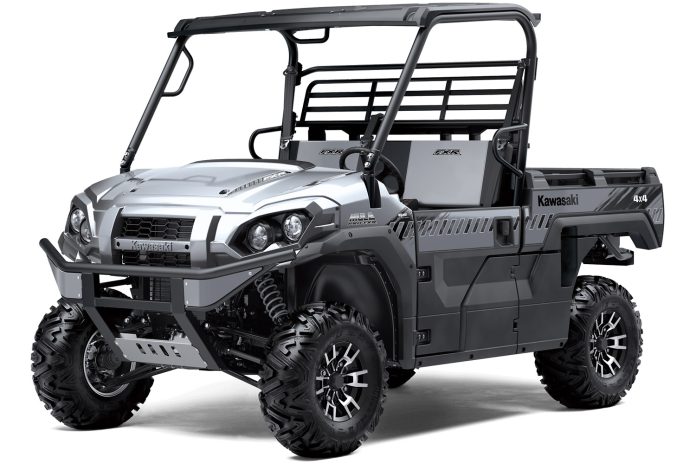We may have been skeptical the first time we got a ride in Kawasaki’s Mule PRO-FX but it didn’t take more than two minutes behind the wheel to be converted.
The FX offered a new level of smoothness in this type of workhorse SxS and it’s due in no small part to its 3-cylinder Chery engine, its linear electric power steering and silken CVT operation.
From the outset we realized in many ways we actually prefer the new Mule to the Teryx. True, the Teryx is a different kind of Sport-Ute vehicle targeted at those seeking fun as a priority and putting hauling prowess second on the list. But this latest Mule is really good at both!
Although it may not be completely fair to put those two head-to-head, at the end of the day, our staff riders were pretty wowed with the PRO-FX.
When we heard about a sportier version of the FX called the PRO-FXR arriving, it immediately piqued our interest.
In this case, “sportier” may be a relative term. Yes, the basic design and appearance of the FX is still very evident with the new FXR, but Kawasaki’s engineers have taken some giant steps to make the FXR lighter, more agile and to get markedly better handling.
For starters, they chopped a full 12-inches out of the overall length of the FX. At 121.5 inches tip to tail, the FXR pivots more easily in the woods and loses 95-lbs of weight in the process compared to the similarly equipped Pro-FX Ranch Edition.
Although 95 lbs may not amount to much more than a couple of full knapsacks, the fact the weight’s been erased low in the chassis makes a huge difference in the way the FXR feels from the drivers seat.
Interestingly, the wheelbase has been reduced a fraction more than the overall length. This brings the wheelbase to 79.7 inches compared to the FXs 92.3.
You’d think the cab area must have been squished a lot to accommodate the new shorter dimensions – not so. The FX’s extra length was condensed by changing the position of the cargo bed on the chassis, actually moving it forward so it abuts the rear of the passenger cage, keeping the bed fairly close in length to what the full sized FX uses. Rear overhang has been reduced and the overall look is very balanced.
Kawasaki has taken pains to upgrade the appearance of the FXR so it appeals to a different demographic than the longer FX. A roof is included, sporty aluminum wheels added and grippier, more aggressive meats are part of the package.
Inside there’s a premium electronic gauge package, tilt steering wheel and nicely contoured seating for the driver and right-side passenger. Oh – and one feature we love: There’s still three-up seating in the front with plenty of legroom for everybody.
Speaking of love, to quote Mr. Darcy, we love, love, love the full doors on both the FX and FXR and we’re so glad Kawasaki didn’t chintz on including these premium latched and hinged doors on the FXR just to save a few pounds weight.
Our test riders couldn’t have been more impressed with the 812cc DOHC triple under the cargo bed and loved it’s predictable power delivery.
The comment was: “This thing is like a little pick-up truck!” It’s true, too. If you licensed the FXR and put it on the street – maybe added a windshield and some of Kawasaki’s cab enclosure options, you could drive the FXR on the street comfortably every day – maybe even take the kids to soccer practice in it.
Handling is much quicker with the reduced wheelbase and length and, overall, there’s just a more sporty feel to the FXR. Although the shock package hasn’t been notably upgraded, the ride from independent A-arms at all corners is very good.
From an ergonomic and utility perspective theres very little compromise: The tilting cargo bed and its tailgate work smoothly and are very good quality, the cab is roomy and comfortable and sight lines out the front are excellent.
We have to give kudos to Kawasaki for the job it’s done on the FXR. We didn’t believe it would be this good. We were wrong.




